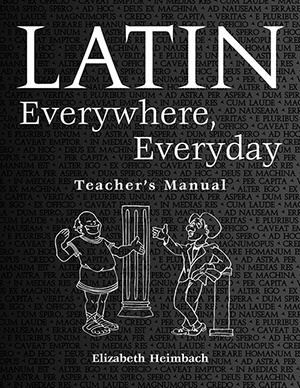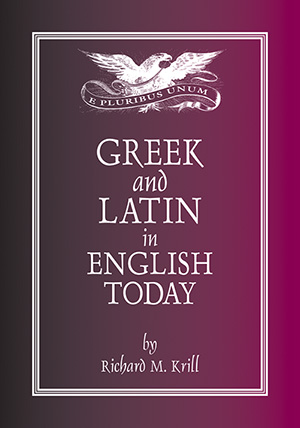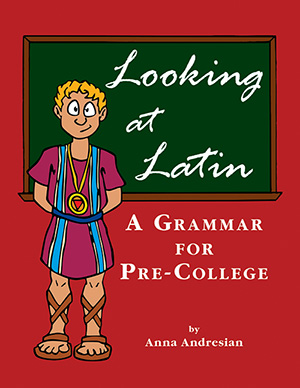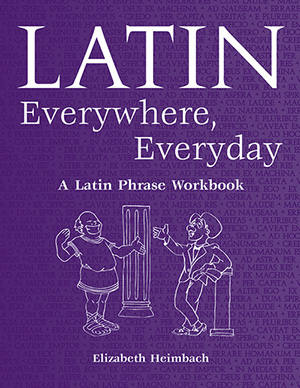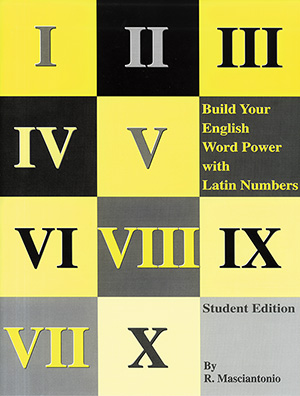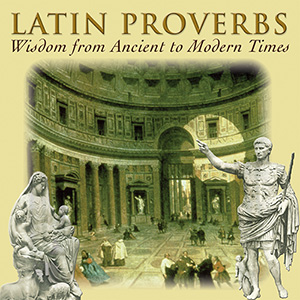Unlike most etymology textbooks, this one presents the words studied in the context of the ideas in which the words functioned. Instead of studying endless lists of word roots, suffixes, and prefixes in isolation, the words are enlivened by the social, literary, and cultural media in which they were used. Readers are introduced to a wide variety of topics from classical antiquity, entertained by clever cartoons, and are able to practice their word knowledge with exercises.
The strength of this textbook is that it presents to high school and college students words in the context of ideas: it is an etymology book that brings words to life.
Special Features
- Introduces students to a wide variety of topics in classical antiquity
- Chapters on Mythology, Medicine, Politics and Law, Commerce and Economics, Philosophy and Psychology, History
- Introduction to word building
- Exercises throughout
- Illustrations of ancient artifacts
- Clever cartoons on word origins
- Three indices: Names and Cultural Topics; Word-Building Topics; English Words and Phrasesr
You can be the first one to write a review.

W. J. DOMINIK (éd.), Words and Ideas, Wauconda (Illinois), BolchazyCarducci
Publishers, 2002, 15.5 x 22.5, XXVII + 281 p., br., ISBN 086516-
485-1, US $ 29.
Pendant des siècles, le latin et le grec furent les langues internationales de l'Occident, ce qui explique la masse de mots anciens contenus dans nos langues occidentals : soixante pour cent des mots anglais courants dérivent du latin et dix pour cent du grec. Permettre aux étudiants - dont beaucoup n'étudient plus ni le latin ni le grec - de comprendre les bases antiques de tous ces mots, étendre leur vocabulaire et éveiller leur curiosité sur les relations entre ces cultures anciennes et la nôtre : tel sont les objectifs poursuivis par ce livre, réalisé de maîtresse façon par un groupe de professeurs universitaires. - Les trois premiers chapitres, les plus arides, apprennent à décortiquer les mots pour en déterminer les composants. Ensuite, sont examines différents groupes de mots d'origine gréco-latine dans des domaines utiles aux étudiants: mythologie, médecine, commerce, économie politique, droit, philosophie, psychologie et histoire. Au lieu de se contenter de listes de mots, propres à engendrer rapidement l'ennui, l'ouvrage essaie de situer les mots dans leur contexte ancien, avec l'appui de courtes et substantielles introductions aux différents aspects de la culture et de la mentalité antiques. A cette fin, les auteurs usent de méthodes variées: cinquante courtes bandes dessinées humoristiques, trente-deux illustrations (photographies parfois trop sombres), de brefs extraits de textes anciens et même modernes, des questionnaires destinés à contrôler la bonne assimilation des chapitres. Chaque chapitre se termine par une bibliographie et une liste de sites internet. Plusieurs index guident les lecteurs. La mise en page est excellente et moderne. - Le tout laisse deviner le talent pédagogique de professeurs ayant déjà expérimenté cette méthode, prévue pour douze à quinze semaines d'étude. C'est une réussite. - B. CLAROT, s.j.
by: B Clarot,– Les Etudes Classiques
Words & Ideas builds vocabulary by explaining Latin and Greek roots of words in the context that they are used. First, the book teaches readers to identify roots, with derivatives, charts to fill in, and even clever comic strips. Later, the roots are grouped into sections such as ‘medicine,’ ‘commerce and economics,’ and ‘history,’ not only defining the roots, but also providing historical background and humorous anecdotes, along with websites that have more information. I heartily applaud the organization of this book-having the roots grouped by context, rather than alphabetically or randomly. This way, they are taught just how they will later be seen, in related sets. Moreover, the glimpses into Roman and Greek culture encourage readers not only to recognize and define the roots of words, but also to put these terms in better context. This is an innovative approach to vocabulary building, introducing roots in related groups.
by: Michelle Wu–
In Words and Ideas, editor William J. Dominik has created an introductory Classics curriculum within the context of a vocabulary builder and beginning etymology textbook. Not only is Words and Ideas multipurpose in scope, but it is also suitable for a variety of learning situations, from autodidacts — yes, you can sit down on your own with Words and Ideas — to homeschooling parents to regular high school or college teachers.
Supplementing each chapter of Dominik’s Words and Ideas, are bibliographies, exercises, websites, and invaluable ‘Word for Word’ cartoon strips. Words and Ideas can be read in almost any order or, if it’s for personal interest, even randomly, but structured approaches would work better in the classroom. For this reason, Dominik suggests two structured approaches: either to focus first on the first three chapters to build up some basic understanding of word building before proceeding to the Greek and Roman culture and further word building sections or to study the first three chapters in conjunction with the remaining nine cultural chapters.
The first three chapters of Words and Ideas introduce word building, with essential, basic, explained terms like base, prefix, and suffix. Dominik explains the creation of hybrid words like ‘sociology,’ which comes from a Latin base and a Greek ending, and the twisted paths by which Latin and Greek words find their way into our English vocabulary. Dominik says ‘About sixty percent of words in common use in English are derived from Latin....’ Dominik’s writing style in this potentially confusing area is clear and precise.
Starting with Chapter 4, Dominik focused on Greco-Roman
culture, the differences between Greece and Rome, and
the essential words used to describe first mythology, then medicine,
politics and law, commerce and economics, philosophy and psychology, and history. In the process, Dominik summarizes:
• the creation stories and major myths of the Greek gods and heroes,
• the change from magic to reason-based medicine,
• the development of the ancient city, democracy and the effect of Roman law on American and South African law,
• financial systems and trade, including slavery and ancient machinery,
• the concept of knowledge, with a quick look at individual pre-Socratics, Plato, Aristotle, and Socrates, the Stoic, Epicurean and Cynic philosophers, with a Freudian excursis, and finally
• the contributions made by historians to our knowledge of times past with a look at and occasional passage written by the ancient philosophers Herodotus, Thucydides, Xenophon, Polybius, Josephus, Caesar, Sallust, Livy, and Tacitus.
Cartoons drive points home quickly and provide easily remembered anecdotes about etymology. Did you know the tree-filled area we know of as an arbor does not come from the Latin word for tree? The (translated into English) literary passages are short. Dominik makes ample use of tables, lists, and bullet points, with occasional illustrations. These techniques make Words and Ideas easy and appealing to use. To keep Words and Ideas short, there is no answer key. This should not be a problem if the student (and homeschooling or other teacher) reads the chapter carefully and keeps a dictionary with etymologies handy.
Words and Ideas may look confusing and not at all like your vision of a word builder, but if you dig through the wealth of clearly presented material and challenging exercises, I think you will agree that you have found a gem.
by: N. S. Gill,– About.com
>William J. Dominik (ed.), Words and Ideas. Wauconda, IL:
>Bolchazy-Carducci, 2002. Pp. 281. ISBN 0-86516-485-1. $29.00 (pb).
>
>Contributors: A. P. Bevis, W. J. Dominik, A. Gosling, J. L. Hilton and
>S. M. Masters
>
>Reviewed by Nicolas P. Gross, University of Delaware (nik@udel.edu)
>Word count: 818 words
>-------------------------------
>
>An old adage claims that a camel is a horse created by a committee. In
>the instance of Words and Ideas, however, the contributors and the
>editor have created a triple crown winner, perhaps even a Seabiscuit.
>In the early 1970's word power courses became very popular, at least at
>large state universities that thrive on heavily-enrolled lecture
>courses. At that time, however, there was no single book, like Words
>and Ideas, that adequately presented materials needed for a roughly
>fifteen week course, and very few that provided much depth or context.
>
>Even without its 164 URL's, Words and Ideas would have been by far the
>best word power book of an earlier era and will, I trust, become a
>standard text for the current generation of students.
>
>The book contains eight chapters: 1) "Word-Building Basics" 2)
>"Word-building tools: Greek Components" 3) "Word-building tools: Latin
>Components" 4) "Mythology" 5) "Medicine" 6) "Politics and Law" 7)
>"Commerce and Economics" 8) "Philosophy and Psychology." While the
>chapters vary somewhat in format "Latin Components" constitutes a
>reasonably good paradigm of the others. To wit: Latin alphabet; Latin
>bases: nouns and verbs; Latin prefixes; Latin suffixes; noun-forming
>suffixes, adjective-forming suffixes, Verb-forming suffixes; Latin
>expressions; Bibliography and Further Reading; Web Sites: Names and
>URLs; and Exercises.
>
>The chapter on "Medicine," to cite another example, begins with a
>summary account of Greek medicine, and then discusses subsets of
>medicine of major importance such as anatomy and physiology and
>associated vocabulary. In the presentation of Roman medicine, a similar
>pattern appears with topics such as "Military Doctors," "Surgery" and
>"Medical and Surgical Instruments," again followed by brief summaries
>of related vocabulary, and concludes with study of both Greek and Latin
>derivatives. The bibliography for this chapter runs the gamut from
>alternatives to Words and Ideas such as Ayers' Bioscientific
>Terminology and Dunmore and Fleischer's Medical Terminology: Exercises
>in Etymology to scholarly treatises such as G. E. R. Lloyd's
>Hippocratic Writings. The web sites offer a comparable breadth from
>"Ancient Medicine" to "Medword."
>
>Ancient texts are frequently cited. Indeed Words and Ideas contains a
>wealth of useful, translated passages relevant to its various
>subsections. In a discussion of the theory of humors, the appropriate
>passage from Hippocrates on the medical effect of geographical location
>is presented in translation (Airs, Waters, Places 1, p. 109). Similarly
>a description of characteristics appropriate for a successful a midwife
>also finds citation (Soranus, Gynecology 1. 2-4, p. 116).
>
>Aristotle's definition of Polis can be found in "Politics and Law." The
>text translated is Aristotle, Politics 1252b-1253a, p. 146. Once
>students have read these brief passages, one hopes that they and
>perhaps their teachers will be inspired to delve further.
>
>The exercises at the conclusion of each chapter contain familiar
>drills: "Explain the origin of the word diagnosis" [diagnosis in bold]
>and "The government attempted to impose its will upon the populace in a
>Procrustean manner." But, as the examples above show, the book is by no
>means bound to brute memorization. The chapter on medicine, for
>example, also asks: "List two basic differences between Greco-Roman
>medical practice and modern Western medical practice. Be sure to
>identify the ancient and modern practices in each difference you cite."
>
>Classicists' love of the languages that they teach finds its way into
>this book through "lessons," large and small, on Latin and ancient
>Greek. A small lesson in Latin: "Give the meaning of each of the
>following Latin phrases in English and for each phrase write a sentence
>of your own in which you incorporate the phrase. a. in camera b. vice
>versa, and so on. In short, the book examines "language" in meaningful
>ways.
>
>In a text of this breadth, an occasional error of detail is all but
>inevitable. On p. 38, there is an error of incorrectly transferred
>location: under the column entitled "Greek word," law is found and
>nomos appears under the column for "meaning of Greek." So too one might
>quibble about the section on "Roman Trade and Transport" for in
>addition to "Road and Sea Transport" there might have been a note on
>the extensive use of the canals on the Italian peninsula during
>antiquity. Perhaps some might also object to the use of drawn pictures
>("cartoons") to illustrate meanings of words, but given the visual
>orientation of today's students and given the amount of memorization
>(anathema to both yesterday's and today's students) involved in any
>word power course, the illustrations are welcome.
>
>In fact, in planning this book, the editor and his contributors faced
>an exceptionally difficult task of selection lest they produce a
>multitome reference work. One could transform the topic "Technology in
>the Greek and Roman World" (a section of chapter 7) into a fifteen week
>course. Given the scope of the endeavor, Words and Ideas is as
>comprehensive as possible and eminently usable by advanced secondary
>school students and by undergraduates. It will serve them well.
>
by: Nicholas Gross,– BrynMawr Classical Review
Which would you prefer to be - a rodent operative or a rat-catcher? Of course the former is derived from the King's Latin whereas the latter is peasant Anglo Saxon. Medieval snobbery about language has survived to sanitise all kinds of modern dirty work. Indeed the importance of knowing the ideas behind words can hardly be underestimated in a society where language seems constantly to be manipulating the public. (Colin Butler's article on Caesar's Gallic Wars commentary in the last issue of JACT Review drew timely attention to this) If you find the ideas and values attached to modern words interesting, if you enjoyed Melvin Bragg's exploration of the English Language on TV and radio, or if you are a teacher anxious to improve student literacy, then you will enjoy this book which is a compendium of key English/American words derived from Latin and Greek.
D's stated aim is to broaden the vocabulary and cultural literacy of students within the context of Classics and other disciplines. The first three chapters explain the basics of word building: he shows how specific nouns, verbs, and adjectives relate to each other and how words can be broken down into the base, prefix, and suffix. The subsequent chapters contain overviews of classical mythology, law, medicine, history, commerce, philosophy, and psychology each followed by tables of Enligh/American words relevant to that particular topic, all with their classical derivations. The arrangement of words into their subject disciplines is why the book is different from other etymological handbooks though there is an alphabetical index if you need it. As an example, the medicine chapter will explain the difference between optometrist, optician, oculist, and ophthalmologist, and the precise meanings of antimelanin and epinephrine. Latin - and Greek- less medical students might find an intensive weekend on this chapter a useful shortcut to medicalese.
The book is attractive, compact, and contains useful extras: bibliographies, related web-sites, lists of Latin/Greek phrases and reasonably amusing cartoons which serve to break up the text. D suggests using the first three chapters as a course book and there are exercises at the end of all the chapters. These would be pretty heavy going for younger students but I adapted some for a bright year 9 latin group on May 13th. They loved the word triskaidekaphobia.
by: Sue Pontin,– JACT Review
Thanks to you, all of you, especially Lew and Marie for sending Words and Ideas to me. I have begun a serious study of it and am fascinated with it, especially loving the organization. I surely shall be adding it to the list of rescources for the National Junior Classical League academic contests beginning in 2004. The first chapter alone or even the word strips alone make it a treasure, truly a thesaurus.
Gaylan DuBose
Academic Contest Chair
NJCL
Latin Teacher, St. Andrew's Episcopal School, Austin, Texas
by: GAYLAN DU BOSE,– GAYLAN DUBOSE
Latin Everywhere, Everyday: A Latin Phrase Workbook Teacher's Manual with audio
Author: Elizabeth Heimbach
Readings and Performance: James W. Chochola
$32.00



